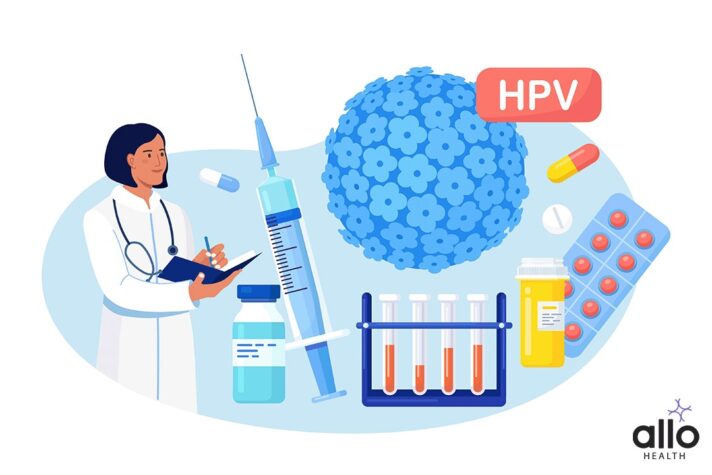Human Papillomavirus (HPV) Infection

Allo Health is dedicated to personalized well-being, offering support and trusted information tailored to individual health goals. The platform emphasizes human-generated content, led by a distinguished medical team of experts, including physicians and sexual health specialists. Their commitment to credibility involves rigorous fact-checking, authoritative research, and continuous updates to ensure accurate, up-to-date information. Allo Health's unique approach goes beyond conventional platforms, providing expert-led insights and a continuous commitment to excellence, with user feedback playing a crucial role in shaping the platform's authoritative voice.

A psychologist with clinical specialization and experience working with sub-clinical and clinical populations. Her areas of interest and expertise include anxiety-related disorders, mood disorders, psychotic disorders, addictions, sexual health and wellness, relationship issues, stress, and geriatric mental health.
Why This Was Upated?
Our experts continually monitor the health and wellness space, and we update our articles when new information became available.
Updated on 04 June, 2024
- Article was updated as part of our commitment to diversity, equity, and inclusion.

"The following blog article provides general information and insights on various topics. However, it is important to note that the information presented is not intended as professional advice in any specific field or area. The content of this blog is for general educational and informational purposes only.
Book consultation
The content should not be interpreted as endorsement, recommendation, or guarantee of any product, service, or information mentioned. Readers are solely responsible for the decisions and actions they take based on the information provided in this blog. It is essential to exercise individual judgment, critical thinking, and personal responsibility when applying or implementing any information or suggestions discussed in the blog."
What Is HPV?
Human papillomavirus (HPV) is a common sexually transmitted infection that affects both men and women. It is the most common sexually transmitted infection globally. According to the World Health Organization (WHO), over 80% of sexually active individuals will contract HPV at some point in their lives.
Types of HPV
Human papillomavirus (HPV) is a common sexually transmitted infection that can cause a range of health concerns, including genital warts and certain types of cancers. In fact, according to the World Health Organization (WHO), HPV is the most common sexually transmitted infection globally, with an estimated 80% of sexually active people acquiring it at some point in their lives.
?
There are over 100 different types of HPV, each with different effects on the human body.
Low-risk HPV
Low-risk HPV types do not usually cause cancer but can cause genital warts. These types of HPV are also known as non-oncogenic HPV types. There are several low-risk HPV types, including HPV 6 and HPV 11, which are the most common types responsible for genital warts. They are highly contagious and can be spread through sexual contact.
High-risk HPV
These types of HPV are also known as oncogenic HPV types. There are several high-risk HPV types, including HPV 16 and HPV 18, which are the most common types responsible for the development of cervical cancer.
HPV 16
HPV 16 is the most common high-risk type of HPV, accounting for more than half of all HPV-related cancers. This type of HPV is known to cause cervical, anal, vulvar, vaginal, penile, and oropharyngeal cancers.
HPV 18
HPV 18 is the second most common high-risk type of HPV and is responsible for approximately 10% of all HPV-related cancers. This type of HPV is known to cause cervical, anal, vulvar, vaginal, and oropharyngeal cancers.
Other high-risk HPV types
In addition to HPV 16 and HPV 18, there are several other high-risk types of HPV, including HPV 31, HPV 33, HPV 45, HPV 52, and HPV 58. These types of HPV can also cause cancer in the genital area and throat.
HPV 6 and HPV 11
HPV 6 and HPV 11 are the most common types of low-risk HPV, responsible for approximately 90% of all genital warts cases. These types of HPV are highly contagious and can be spread through sexual contact.
Other low-risk HPV types
In addition to HPV 6 and HPV 11, there are several other low-risk types of HPV, including HPV 42, HPV 43, and HPV 44. These types of HPV can also cause genital warts.
Causes of HPV
Human papillomavirus (HPV) is a common sexually transmitted infection (STI) that affects both men and women. It is transmitted through skin-to-skin contact during sexual activity. While most people with HPV do not experience any symptoms, some can develop genital warts or certain types of cancer.
Sexual activity
The primary cause of HPV is sexual activity. HPV is transmitted through skin-to-skin contact during sexual activity, including vaginal, anal, and oral sex. Anyone who has ever had sex can contract HPV, regardless of their age or sexual orientation. The risk of HPV infection is higher for people who have had multiple sexual partners or who have sex with someone who has had multiple partners.
Weakened immune system
A weakened immune system can also increase the risk of HPV infection. This includes people with HIV/AIDS or those who have undergone an organ transplant, as their immune systems are suppressed by medications. People who smoke or are under a lot of stress may also have a weaker immune system, which can make them more susceptible to HPV.
Lack of vaccination
Another cause of HPV is a lack of vaccination. The HPV vaccine is highly effective at preventing infection with the most common types of HPV that can cause cancer. The Centers for Disease Control and Prevention (CDC) recommends that all children aged 11-12 years receive the HPV vaccine, as well as anyone up to age 26 who has not been vaccinated. The vaccine is most effective when given before sexual activity begins.
Genetics
While the role of genetics in HPV infection is not fully understood, some studies suggest that genetics may play a role in how a person’s immune system responds to the virus. This may affect the likelihood of developing genital warts or certain types of cancer.
Poor personal hygiene
Poor personal hygiene can also increase the risk of HPV infection. This includes not washing hands regularly, not cleaning sex toys between uses, and not showering after sexual activity. These habits can make it easier for HPV to spread from person to person.
Symptoms of HPV
The symptoms of HPV can vary depending on the type of HPV a person has contracted. In some cases, people may not experience any noticeable symptoms at all. However, there are several symptoms that are commonly associated with HPV, including:
Genital warts
Genital warts are a common symptom of low-risk HPV. These warts can appear on the penis, vulva, vagina, anus, or cervix, and can range in size from tiny bumps to larger clusters. They may be flesh-colored, pink, or red and may be flat or raised.
Abnormal pap smear
A pap smear is a screening test that is used to detect abnormal cells in the cervix. Abnormal pap smear results can indicate the presence of HPV and may require further testing or treatment.
Cervical dysplasia
Cervical dysplasia is a condition in which the cells in the cervix begin to grow abnormally. This can be caused by high-risk HPV and can lead to cervical cancer if left untreated.
Anal cancer
High-risk HPV can also cause anal cancer, which can cause symptoms such as bleeding from the anus, pain during bowel movements, and changes in bowel habits.
Penile cancer
Men who contract high-risk HPV may be at increased risk of developing penile cancer. Symptoms of this type of cancer can include changes in the skin of the penis, such as thickening or discoloration, and lumps or growths on the penis.
Vulvar cancer
High-risk HPV can also cause vulvar cancer, which can cause symptoms such as itching, pain, and changes in the skin of the vulva.
Risk Factors of HPV
-
Sexual activity: HPV is primarily spread through sexual activity, including vaginal, anal, and oral sex. People who are sexually active with multiple partners are at a higher risk of contracting HPV.
-
Age: HPV is more common among younger people, with the highest rates of infection occurring in people in their late teens and early 20s.
-
Immune system: People with weakened immune systems are at a higher risk of developing HPV-related cancers. This includes people living with HIV, organ transplant recipients, and those undergoing chemotherapy.
-
Smoking: Smoking can weaken the immune system and increase the risk of developing HPV-related cancers.
-
Genetics: Some people may be more genetically predisposed to developing HPV-related cancers than others.
-
Gender: HPV is more commonly associated with certain cancers in women, such as cervical cancer. However, men can also develop HPV-related cancers, including anal, penile, and throat cancers.
How HPV Spreads?
HPV spreads through skin-to-skin contact with someone who has the virus. It’s most commonly spread through sexual contact, including vaginal, anal, and oral sex. HPV can be spread even if there are no visible signs or symptoms, and a person can transmit the virus to their partner without even realizing it.
?
In addition to sexual contact, HPV can also spread through non-sexual skin-to-skin contact. For example, if someone has a wart caused by HPV on their hand, they could spread the virus by touching another person’s skin.
?
Condoms and other forms of protection are not always effective at preventing the spread of HPV. While condoms can reduce the risk of transmission, they do not cover all potentially infected skin.
Types Of Viruses That Can Cause HPV
Human papillomavirus (HPV) is a group of viruses that infects the skin and mucous membranes. HPV is known for causing genital warts, but it can also lead to more serious conditions, such as cervical cancer. There are many different types of HPV, and each type can cause different symptoms and health concerns.
Low-risk HPV
Low-risk HPV (LR-HPV) refers to a group of viruses that can cause genital warts. These warts are usually small, flesh-colored bumps that appear on or around the genital area. LR-HPV can also cause warts in the mouth and throat. While these warts are not usually cancerous, they can be uncomfortable and may require treatment.
High-risk HPV
High-risk HPV (HR-HPV) refers to a group of viruses that are known to cause cancer. HR-HPV is responsible for most cases of cervical cancer, as well as some cases of anal, vulvar, vaginal, penile, and oropharyngeal cancers. Most people with HR-HPV do not develop cancer, but the virus can increase the risk of cancer.
Types of high-risk HPV
There are several types of high-risk HPV, including HPV 16 and HPV 18. These two types of HPV are responsible for the majority of cervical cancer cases. Other high-risk HPV types include HPV 31, HPV 33, HPV 35, HPV 39, HPV 45, HPV 51, HPV 52, HPV 56, HPV 58, and HPV 59. Each of these types of HPV can cause cancer, but HPV 16 and HPV 18 are the most dangerous.
Other types of HPV
In addition to LR-HPV and HR-HPV, there are several other types of HPV. These include:
-
Cutaneous HPV: This type of HPV infects the skin and can cause warts on the hands, feet, and other parts of the body.
-
Mucosal HPV: This type of HPV infects the mucous membranes, including the mouth, throat, and genital area. Mucosal HPV can cause warts, as well as more serious conditions like cancer.
-
Epidermodysplasia verruciformis (EV) HPV: This rare type of HPV can cause scaly, wart-like growths on the skin. EV HPV is also associated with a higher risk of skin cancer.
How Can HPV Affect Your Sex Life?
Transmission
One of the most significant ways in which HPV can affect your sex life is by increasing the risk of transmission to your partner(s). HPV is highly contagious and can be transmitted through any type of sexual contact, including vaginal, anal, and oral sex. If you have HPV, it’s essential to practice safe sex and use condoms or dental dams to reduce the risk of transmission to your partner(s).
Genital warts
Some types of HPV can cause genital warts, which can appear as small, flesh-colored bumps or clusters of bumps. Genital warts can be itchy or painful and can cause discomfort during sexual activity. While they can be treated with medication, they can also recur after treatment. Genital warts can also be a source of embarrassment or shame, which can affect your sexual confidence and intimacy with your partner(s).
Cancer
Certain types of HPV can cause cancer of the cervix, anus, penis, or throat. These types of cancer can be serious and potentially life-threatening. If you have HPV, it’s important to get regular screenings for cancer, especially if you have a higher risk due to factors such as smoking or a weakened immune system. HPV-related cancer can also affect your sexual relationships, as it may require medical treatments that can impact your sexual function.
Emotional impact
HPV can also have an emotional impact on your sex life. If you have HPV, you may feel anxious or worried about how it will affect your relationships or future sexual encounters. You may also feel guilty or ashamed if you have transmitted HPV to your partner(s). It’s important to talk openly with your partner(s) about your HPV status and practice safe sex to reduce the risk of transmission.
What Doctor Do You Go To?

The answer to this question depends on a few factors, including your age, gender, and the specific symptoms you are experiencing. Here are some guidelines to help you determine which doctor to see for HPV.
General Practitioner (GP)
If you are experiencing symptoms such as genital warts, abnormal vaginal bleeding, or pain during sex, your first step should be to make an appointment with your general practitioner (GP). A GP is a primary care doctor who can diagnose and treat a wide range of health concerns, including HPV. Your GP may refer you to a specialist if they feel that your condition requires more specialized care.
Gynecologist
If you are a woman experiencing symptoms related to HPV, such as abnormal pap test results or cervical cancer, you may need to see a gynecologist. A gynecologist is a doctor who specializes in women’s reproductive health. They can perform exams such as pelvic exams, pap tests, and HPV tests, and can provide treatment for a variety of conditions related to the reproductive system.
Urologist
If you are a man experiencing symptoms related to HPV, such as genital warts or anal cancer, you may need to see a urologist. A urologist is a doctor who specializes in the urinary tract and male reproductive system. They can perform exams such as prostate exams and provide treatment for a variety of conditions related to the urinary tract and reproductive system.
Oncologist
If you have been diagnosed with HPV-related cancer, such as cervical or anal cancer, you may need to see an oncologist. An oncologist is a doctor who specializes in the treatment of cancer. They can provide a range of treatments, including surgery, chemotherapy, and radiation therapy, depending on the type and stage of your cancer.
Complications From Untreated HPV
Genital warts
Genital warts are the most common complication of HPV. They are small, flesh-colored or gray growths that appear on the genitals or anus. They can be painful or itchy or bleed and cause emotional distress. Genital warts are caused by certain types of HPV that are not associated with cancer.
Cervical cancer
Cervical cancer is the second most common cancer in women worldwide, and it is caused by certain types of HPV. If left untreated, HPV can cause abnormal cell changes in the cervix that can lead to cancer. The early stages of cervical cancer may not cause any symptoms, but as the cancer progresses, symptoms may include vaginal bleeding, pain during sex, and pelvic pain.
Anal cancer
Like cervical cancer, anal cancer is also caused by certain types of HPV. It is more common in men who have sex with men, but it can also affect women. Symptoms of anal cancer may include anal bleeding, pain or pressure in the anus, or a lump in the anal area.
Oropharyngeal cancer
Oropharyngeal cancer is a type of throat cancer that is caused by certain types of HPV. It affects the back of the throat, including the base of the tongue and the tonsils. Symptoms of oropharyngeal cancer may include a sore throat, difficulty swallowing, ear pain, or a lump in the neck.
Recurrent respiratory papillomatosis
Recurrent respiratory papillomatosis is a rare condition that is caused by HPV. It affects the respiratory tract, including the larynx and trachea. The condition causes wart-like growths to form in the airway, which can lead to difficulty breathing and a hoarse voice. It can also lead to complications such as pneumonia or respiratory failure.
How to Prevent HPV?
Human papillomavirus (HPV) is a common sexually transmitted infection that affects both men and women. HPV can cause genital warts and certain types of cancer, including cervical cancer, anal cancer, and oropharyngeal cancer. Fortunately, there are several steps you can take to prevent HPV.
-
Get vaccinated: One of the most effective ways to prevent HPV is to get vaccinated. The HPV vaccine is recommended for both boys and girls aged 11 or 12, and is most effective when given before any sexual activity. The vaccine is also recommended for men up to age 26 and women up to age 45 who have not been vaccinated previously.
-
Practice safe sex: Using condoms or dental dams during oral, vaginal, and anal sex can help reduce your risk of contracting HPV. However, condoms do not provide 100% protection against HPV, as the virus can be spread through skin-to-skin contact with infected areas that are not covered by a condom.
-
Limit sexual partners: Having multiple sexual partners increases your risk of contracting HPV, as well as other sexually transmitted infections. Limiting your number of sexual partners can help reduce your risk of contracting HPV.
-
Get regular check-ups: Regular check-ups with your healthcare provider can help detect HPV and other sexually transmitted infections early. Women should have regular pap tests, which can detect abnormal cells in the cervix that may be a sign of cervical cancer. Men and women can also get an anal pap test, which can detect abnormal cells in the anus that may be a sign of anal cancer.
-
Maintain good health habits: Maintaining good health habits, such as getting enough sleep, exercising regularly, and eating a healthy diet, can help boost your immune system and reduce your risk of contracting HPV.
-
Avoid smoking: Smoking weakens the immune system, making it more difficult for your body to fight off infections such as HPV. Quitting smoking or avoiding smoking altogether can help reduce your risk of contracting HPV.
Prevalence and Incidence of HPV In India
According to a study conducted by the Indian Council of Medical Research (ICMR), the overall prevalence of HPV in India is 6.6%. The prevalence is highest in the age group of 30-34 years (10.3%), followed by the age group of 25-29 years (9.1%). The study also found that the prevalence of high-risk HPV types, which are known to cause cervical cancer, is 3.2%.
?
Another study published in the Journal of Obstetrics and Gynaecology of India reported that the incidence of cervical cancer in India is 22.86 per 100,000 women per year. Cervical cancer is the most common cancer among Indian women, and HPV infection is the leading cause of cervical cancer.
Impact on Public Health
The high prevalence and incidence of HPV in India have a significant impact on public health. HPV infection can lead to various types of cancers, including cervical, anal, vaginal, penile, and oropharyngeal cancer. Cervical cancer is the most common cancer among Indian women, and it is estimated that there are about 122,000 new cases and 67,000 deaths due to cervical cancer in India every year.
Measures Taken to Control the Spread of HPV
To control the spread of HPV in India, the government has launched several initiatives. The Ministry of Health and Family Welfare launched a national program for the prevention and control of cancer, diabetes, cardiovascular diseases, and stroke in 2017. The program focuses on the early detection and treatment of cancer, including cervical cancer.
?
The government has also introduced the HPV vaccine as part of the national immunization program. The vaccine is given to girls between the ages of 9 and 14 years, and it protects against the two high-risk HPV types that cause cervical cancer.
?
In addition to these initiatives, there is a need for awareness campaigns to educate people about the importance of safe sex practices, regular screening for cervical cancer, and the HPV vaccine.
You Shouldn’t Be Embarrassed About Having HPV
It’s incredibly common
As we mentioned earlier, the vast majority of sexually active people will contract HPV at some point in their lives. It’s so common that the Centers for Disease Control and Prevention (CDC) estimate that there are 14 million new cases of HPV each year in the United States alone. If you have HPV, you’re far from alone.
It’s not a sign of promiscuity
Some people may think that contracting an STI like HPV is a sign that someone is promiscuous or irresponsible. However, this is simply not true. HPV can be contracted even if you’ve only had one sexual partner in your lifetime. It’s important to remember that anyone who is sexually active can contract an STI, and there is no shame in that.
It doesn’t define you
Having HPV doesn’t define who you are as a person. It’s simply an infection that you have, much like a cold or the flu. It’s important to remember that you are not your diagnosis, and there is much more to you than the fact that you have HPV.
You can still have a healthy sex life
If you have HPV, it’s still possible to have a healthy and fulfilling sex life. It’s important to be honest with your partner(s) about your diagnosis and take steps to protect yourself and your partner(s) from further transmission. Using condoms and getting vaccinated against HPV are both effective ways to reduce the risk of transmission.
How To Approach Intimacy With A HPV Diagnosis?
Here are some tips on how to approach intimacy with an HPV diagnosis:
Educate Yourself About HPV
The first step in dealing with an HPV diagnosis is to educate yourself about the infection. Learn about the different types of HPV, their symptoms, and the ways in which they can be transmitted. This will help you better understand your diagnosis and communicate more effectively with your partner.
Communicate with Your Partner
It is important to communicate with your partner about your HPV diagnosis before engaging in any sexual activity. Be honest and open about your diagnosis, and provide your partner with accurate information about the virus. This will help to ensure that your partner understands the risks and can make an informed decision about whether or not to engage in sexual activity.
Practice Safe Sex
Using condoms or dental dams during sexual activity can help to reduce the risk of transmitting HPV to your partner. However, it is important to note that condoms do not provide complete protection against HPV. This is because HPV can be transmitted through skin-to-skin contact in areas that are not covered by a condom.
Get Regular Pap Tests
If you have been diagnosed with HPV, it is important to get regular pap tests. Pap tests can help to detect abnormal cells in the cervix that may be a sign of cervical cancer. Women with HPV should get a pap test every three years, or as recommended by their healthcare provider.
Seek Treatment for Genital Warts
If you have genital warts, it is important to seek treatment. There are a variety of treatment options available, including topical creams, freezing, and surgery. Treating genital warts can help to reduce the risk of transmitting the virus to your partner.
Take Care of Your Emotional Health
Receiving an HPV diagnosis can be emotionally challenging. It is important to take care of your emotional health by seeking support from friends, family, or a mental health professional. This can help you to cope with the diagnosis and to maintain a healthy and positive outlook on life.
Frequently Asked Questions
1. Is there a test for HPV?
Yes, there is a test for HPV. Women can get a pap test, which checks for abnormal cells on the cervix that could be caused by HPV. There is also an HPV test that can be done in conjunction with a pap test.
?
2. Is HPV only a problem for women?
No, HPV can affect both men and women. HPV s can also cause other types of cancer in both men and women besides cervical cancer, including anal cancer, penile cancer, and throat cancer.
?
3. How can I reduce my risk of getting HPV?
The best way to reduce your risk of getting HPV is to practice safe sex. This means using a condom during vaginal, anal, and oral sex. It is also important to get vaccinated against HPV and get regular pap tests if you are a woman.
Sexual health is as important as physical and mental health. In most cases, one consultation can go a long way. Personalised, discreet, and judgement-free treatment at your fingertips – book an online consultation with one of Allo?s leading experts.







































